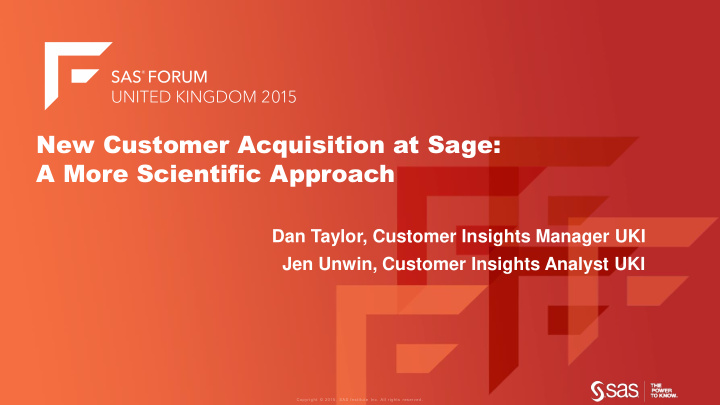



New Customer Acquisition at Sage: A More Scientific Approach Dan Taylor, Customer Insights Manager UKI Jen Unwin, Customer Insights Analyst UKI
What are we going to cover? About Sage Our Analytics Team Preparing to Model Using Enterprise Guide & Miner Model Execution
Who is Sage? SALVIA OFFICINALIS SAGE GATESHEAD
SAS Users at Sage UKI
Analytics in Sage Increasing Complexity Descriptive Inferential Predictive (1981+) (2000+) (2010+)
Who Should We Target? Strengths & ‘New’ Sage Customers ‘Non’ Sage Customers Weaknesses Direct Indirect Construction Manufacturing Accountant Health and social care Partner Vs £0-£20k £21-£40k Core Enhancements £10m+ Core Enhancements Unknown employees 0-10 employees 200+ employees
The ‘Blind File’ – Start the clock! 380k records UK Universe 200+ variables Matched Sage Customers URN 200+ variables Contactability Target Variables 380k Blind File 50 93 SSB/AD/SMB S1 299 Prospects Non-Matched Sage Customers
Analysing the Blind File
Modelling in Enterprise Guide: RPM Modelling Method: Basic, Intermediate, Advanced? Intermediate W hy? - Over 100 Variables - Compare several different modelling techniques
‘Miner’ Changes Other Model Types Sample Size Exports Interactive Binning
Translation Back to the Business: Binning Node Modified Bandings Less than 2 Employees Original Model Variable Division 2 - 4 Employees Less than 3.5 Employees 5 - 9 Employees 3.5 - 44.5 Employees 10 - 19 Employees More than 44.5 Employees 20 - 49 Employees 50 - 99 Employees 100+ Employees
Returning to the Blind File: Combining Variables
Evaluation of Models
Comparing Multiple Models Model Development Model Reduction Model Translation Model Allocation Highest 50% of P values for each Average Unit model Price (AUP) Direct Web Direct sales Model 𝒚 Web Store P value Indirect sales Model Fit Accountant <50% pass Partner >50% fail = 𝑸𝒘𝒃𝒎𝒗𝒇 𝒙𝟐 × 33 Models 𝑵𝒑𝒆𝒇𝒎 𝑮𝒋𝒖 𝒙𝟑 × Model 𝒛 𝑩𝑽𝑸 𝒙𝟒
Modelling Process - Takeaways Expectations The Input File Data Partnership Results Presentation Use the modelling bi-products Learn from Mistakes Use SAS
Thank you Any Questions?
Recommend
More recommend